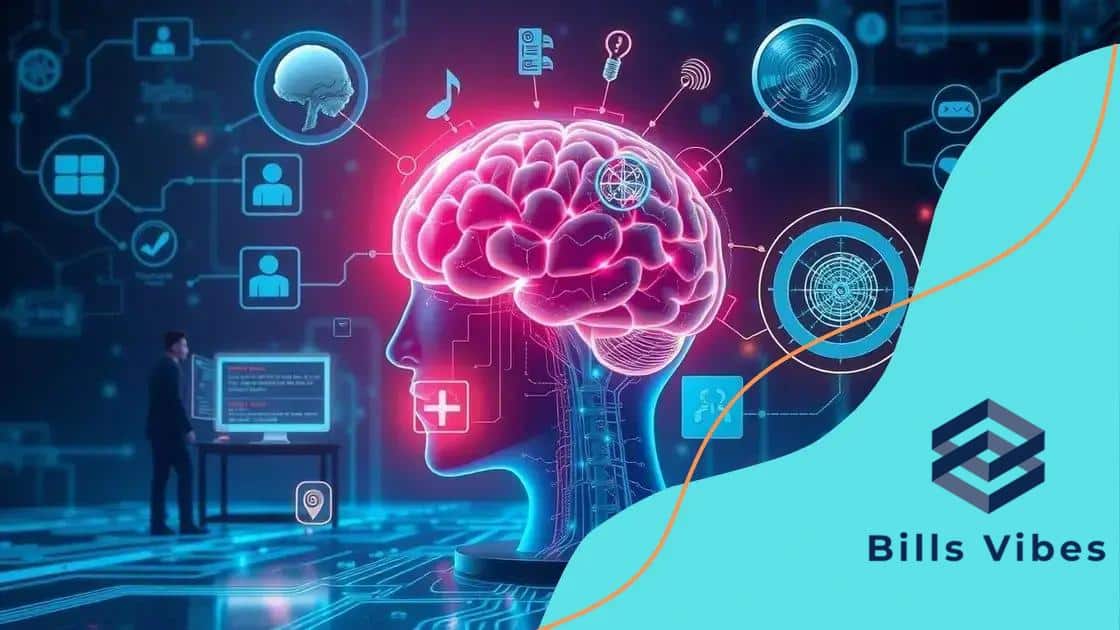Brain-computer interfaces 2025: what to expect

Brain-computer interfaces (BCIs) enable direct communication between the brain and devices, offering transformative applications such as improving accessibility, enhancing communication for individuals with disabilities, and potentially facilitating direct brain-to-brain communication.
Brain-computer interfaces 2025 promise to transform how we connect with technology. Imagine controlling devices with just your thoughts! This article explores what’s on the horizon for this groundbreaking technology.
Understanding brain-computer interfaces
Understanding brain-computer interfaces is vital as technology continues to advance. These interfaces allow a direct communication pathway between the brain and external devices, enabling users to control technology through thought. This opens up new possibilities for many applications, especially in fields like medicine and gaming.
How do brain-computer interfaces work?
Brain-computer interfaces (BCIs) interpret brain signals and translate them into actionable commands. This is typically done using electrodes that detect electrical activity from the brain. The data is then processed using algorithms that discern the user’s intent from the signals.
Key components of BCIs
- Electrodes: These capture brain signals.
- Signal processing: This interprets the signals into meaningful data.
- Feedback systems: These provide users with real-time responses to their commands.
As we delve deeper into this technology, it’s essential to consider its potential. Imagine controlling your computer or prosthetic limb simply by thinking about it! This notion is becoming increasingly achievable with advancements in brain-computer interface technology.
One of the most exciting developments in BCIs is their use in assistive technology. For instance, individuals who are paralyzed can regain some control over their environment with these devices. By detecting brain signals related to necessary movements, BCIs can link to devices that perform tasks, such as moving a cursor on a screen or operating a wheelchair.
Research in brain-computer interfaces is ongoing, and the applications are virtually limitless. In gaming, for example, players may soon enjoy experiences that fully immerse them by controlling games through thought alone. This could redefine interaction in virtual environments, making them more intuitive and accessible.
History and evolution of brain-computer interfaces
The history and evolution of brain-computer interfaces (BCIs) reveal fascinating advancements in technology and neuroscience. This journey began with basic experiments on brain activity, which laid the groundwork for understanding how brain signals can control devices.
Early developments
In the 1960s, researchers started exploring the connections between the brain and machines. One of the first significant breakthroughs occurred with the development of electroencephalography (EEG), which allowed scientists to measure electrical activity in the brain. This paved the way for the first rudimentary BCIs.
Progress through the decades
- 1970s: Initial experiments showed that trained subjects could control simple devices using brain signals.
- 1980s: Major advancements in signal processing made it possible to interpret brain activity more precisely.
- 1990s: Researchers conducted more sophisticated studies, leading to the development of systems that allowed users to control cursors on screens.
As we moved into the 2000s, the pace of innovation accelerated even further. New materials and technologies enabled more effective and comfortable interfaces. Researchers began focusing on practical applications, especially for people with disabilities. The potential of BCIs started becoming a reality.
In recent years, several companies have developed consumer-oriented BCIs, opening new opportunities in entertainment and gaming. This evolution showcases the rapid progress of brain-computer interfaces and highlights a future where thought-controlled devices may become commonplace.
As technology continues to advance, who knows what the future holds? We might soon see even more innovative applications of BCIs that further enhance our daily lives.
Potential applications by 2025

The potential applications of brain-computer interfaces (BCIs) by 2025 are both exciting and transformative. As technology evolves, these interfaces could revolutionize many aspects of our daily lives. One of the most significant areas of impact will be healthcare.
Healthcare improvements
BCIs have the potential to assist individuals with disabilities and neurological disorders. Imagine patients being able to control prosthetic limbs or wheelchairs using only their thoughts. This advancement could significantly enhance mobility and independence.
Enhancing communication
Another exciting application is in communication for those who are non-verbal. BCIs could enable users to translate their thoughts into speech. This would be a game-changer for many individuals who struggle to communicate due to conditions like ALS or stroke.
- Increased accessibility: BCIs can provide new ways for people with disabilities to interact with technology.
- Thought-controlled devices: Consumer electronics could become controlled by mere thoughts, making technology more intuitive.
- Gaming experiences: BCIs could allow gamers to play using their minds, creating immersive experiences.
Education is another field that stands to benefit from BCIs. Imagine students learning through direct brain interaction with systems that adapt to their thoughts and needs. This could revolutionize personalized learning and make education more effective.
As research continues to expand, the integration of BCIs into everyday life is becoming increasingly plausible. We could witness significant advancements in areas such as virtual reality, where users may interact with environments purely through brain activity.
Challenges facing brain-computer interfaces
Challenges facing brain-computer interfaces (BCIs) are significant and must be addressed to unlock their full potential. As this technology advances, several hurdles remain in the way of widespread adoption and practical application.
Technical limitations
One major challenge is the technical complexity of BCIs. Accurately capturing and interpreting brain signals can be difficult. Noise and interference can disrupt the signals, making it challenging to produce reliable outcomes. Developers are constantly working to improve the accuracy and efficiency of these systems.
Ethical concerns
Another significant challenge involves ethical considerations. Issues of privacy and consent arise when dealing with brain data. Who owns the information collected by BCIs? Ensuring that all users have control over their data is essential.
- Privacy risks: Unauthorized access to brain data could lead to misuse of information.
- Informed consent: Users must be fully aware of what participation in BCI research entails.
- Social implications: There are potential impacts on equality and accessibility for different groups.
Regulatory frameworks for BCIs are still developing. Governments and organizations need to create guidelines to ensure safety and effectiveness. This is crucial for fostering trust among users and developers. Furthermore, the high cost of developing and implementing BCIs may limit access for many potential users.
Future advancements may continue to face these hurdles, but researchers and innovators are working diligently to overcome them. Incremental improvements in technology, combined with a strong focus on ethics, will be key to the success of brain-computer interfaces in the coming years.
The future of communication with BCIs
The future of communication with brain-computer interfaces (BCIs) is bright and full of possibilities. These devices have the potential to change how we interact with one another and the world around us. As technology evolves, communication may become more direct, intuitive, and efficient.
Direct brain-to-brain communication
One exciting possibility is direct brain-to-brain communication. Imagine being able to share thoughts and feelings with someone else instantly. This could lead to deeper connections and understanding among people. Researchers are exploring ways to make this a reality, although it is still in the early stages.
Enhanced communication for individuals with disabilities
BCIs could play a significant role in helping those with speech impairments communicate more effectively. For instance, users could translate their thoughts into speech using BCIs, breaking down barriers faced by individuals with conditions such as ALS or cerebral palsy.
- Real-time thought translation: BCIs may enable immediate conversion of thoughts into spoken words, enhancing interaction.
- Adaptive communication tools: Devices could learn from users’ brain patterns to improve communication interfaces.
- Unified platforms: BCIs could integrate with smartphones and computers to create unified communication experiences.
Moreover, in professional settings, BCIs could streamline communication during meetings and collaborations. Imagine teams sharing ideas directly, reducing misunderstandings and increasing productivity.
The evolution of social media might also be impacted. Instead of typing out messages, individuals could share experiences or emotions instantly. This could change how we perceive social interaction and connectivity in the digital age.
As we consider the future, the integration of BCIs in communication promises new horizons. While there are challenges ahead, the potential benefits for human interaction are immense, paving the way for a future where communication transcends traditional barriers.
FAQ – Frequently Asked Questions about Brain-Computer Interfaces (BCIs)
What are brain-computer interfaces?
Brain-computer interfaces (BCIs) are devices that create a direct communication pathway between the brain and external devices, enabling control through thought.
How can BCIs improve communication for individuals with disabilities?
BCIs can help individuals with communication impairments by translating thoughts into speech, facilitating easier interaction.
What are the potential challenges of BCIs?
Challenges include technical limitations, ethical concerns about privacy, and the need for regulatory frameworks to ensure safety and effectiveness.
What future applications can we expect from BCIs?
Future applications may include direct brain-to-brain communication, enhanced accessibility in technology, and more immersive gaming experiences.






